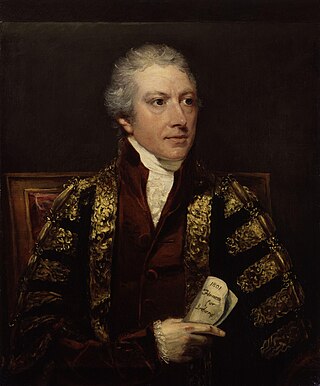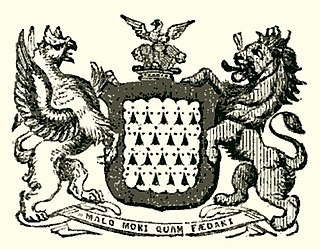Notes
- ↑ Catholic Hierarchy
- ↑ Brady, W. Maziere (1876a). The Episcopal Succession in England, Scotland and Ireland, A.D. 1400 to 1875. Vol. 1. Rome: Tipografia Della Pace.
John Linegar (b and d Dublin; 1671 - 1757) was an Irish Roman Catholic bishop in the mid 18th century. [1]
Linegar was born in Broadstone, Dublin and ordained priest in 1694. He trained for the priesthood in the Irish College at Lisbon, and he served as a curate in St. Michan's Catholic Church, Dublin. He was appointed Archbishop of Dublin in 1734. [2] He died in post on 21 June 1757.
The Primacy of Ireland belongs to the diocesan bishop of the Irish diocese with highest precedence. The Archbishop of Armagh is titled Primate of All Ireland and the Archbishop of Dublin Primate of Ireland, signifying that they are the senior clerics on the island of Ireland, the Primate of All Ireland being the more senior. The titles are used by both the Catholic Church in Ireland and Church of Ireland. Primate is a title of honour, and in the Middle Ages there was an intense rivalry between Armagh and Dublin as to seniority. The Archbishop of Armagh's leading status is based on the belief that his see was founded by St. Patrick, making Armagh the ecclesiastical capital of Ireland. On the other hand, Dublin is the political, cultural, social, economic and secular centre of Ireland, and has been for many centuries, thus making the Archbishop of Dublin someone of considerable influence, with a high national profile. The dispute between the two archbishoprics was settled by Pope Innocent VI in 1353, with occasional brief controversy since. The distinction mirrors that in the Church of England between the Primate of All England, the Archbishop of Canterbury, and the Primate of England, the Archbishop of York.

Charles Abbot, 1st Baron Colchester PC, FRS was a British barrister and statesman. He served as Speaker of the House of Commons between 1802 and 1817.

The Irish Rebellion of 1798 was a popular insurrection against the British Crown in what was then the separate, but subordinate, Kingdom of Ireland. The main organising force was the Society of United Irishmen. First formed in Belfast by Presbyterians opposed to the landed Anglican establishment, the Society, despairing of reform, sought to secure a republic through a revolutionary union with the country's Catholic majority. The grievances of a rack-rented tenantry drove recruitment.

John Hely later Hely-Hutchinson was an Anglo-Irish lawyer, politician, and academic who served as the 21st Provost of Trinity College Dublin from 1774 to 1794. He also served as Principal Secretary of State for Ireland from 1766 to 1794. He was a member of the Irish House of Commons from 1759 to 1794.
Mount Merrion is a suburb of Dublin, Ireland. It is roughly 7 kilometres (5 mi) south of Dublin city centre and is situated on and around the hill of the same name.

John Bowes, 1st Baron Bowes PC (I) was an Anglo-Irish peer, politician and judge. He was noted for his great legal ability, but also for his implacable hostility to Roman Catholics.

General Henry Lawes Luttrell, 2nd Earl of Carhampton PC was an Anglo-Irish politician and soldier, who both in public and private life attracted scandal. He was spurned by colleagues in the British House of Commons who believed that in the election of 1769 he had played an underhand role in denying his seat to the popular choice, the reformer John Wilkes. In 1788 he was publicly accused in Dublin of raping a twelve-year-old girl. Ten years later, his command in the suppression of the Irish rebellion of 1798 was criticised by fellow officers for its savagery, and not least against women. His last years in Parliament were marked by his opposition to Catholic Emancipation, and to parliamentary reform.

Robert Barnewall, 12th Baron Trimlestown was a prominent Anglo-Irish landowner, active in the Roman Catholic cause.
Thomas Burke was an Irish Dominican and Roman Catholic Bishop of Ossory.
Events from the year 1757 in Ireland.
Events from the year 1683 in Ireland.

Charles O'Conor, RIA, also known as Charles O'Conor of Belanagare, was a member of the Gaelic nobility of Ireland and antiquarian who was enormously influential as a protagonist for the preservation of Irish culture and Irish mythology during the 18th-century. He combined an encyclopaedic knowledge of Irish manuscripts and Gaelic culture in demolishing many specious theories and suppositions concerning Irish history.
John Cradock (alias Craddock) (c. 1708 - 10 December 1778) was an English churchman, Church of Ireland Archbishop of Dublin from 1772.
Irish College at Lisbon or St Patrick's College, Lisbon was set up during the Penal Times, by a group of Irish Jesuits, supported by a number of Portuguese Nobles, in Lisbon.

Anthony Malone was an Irish lawyer and politician.
Joseph Story was an 18th-century Anglican bishop in Ireland.

Kenure House was a large Georgian house and estate in Rush, County Dublin, Ireland. The main house was constructed between 1703 and 1713 by the Duke of Ormond on the grounds of an earlier house but was destroyed by fire and rebuilt around 1827. A later portico and further additions were added in 1842 to a design by George Papworth. The main house was demolished by Dublin Corporation in 1978 and the granite portico is the only portion of the main house which still stands as of 2022.
Richard Lincoln (1707–1763) was an Irish Roman Catholic bishop.

St. Michan's Catholic Church is a Catholic Church located on the Northside of Dublin, Ireland. It is the parish church for the Halston Street Parish in the Archdiocese of Dublin.